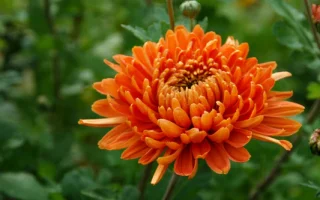kimzolciakwedding.com – The Trumpet Vine (Campsis radicans), also known as the Trumpet Creeper, is a stunning and fast-growing flowering vine native to the southeastern United States. Renowned for its vibrant, trumpet-shaped flowers and ability to quickly cover fences, trellises, and arbors, this plant is a favorite for gardeners who want to add both vertical interest and a burst of color to their landscapes. In this article, we will explore the features, growing conditions, and benefits of the Trumpet Vine flower, and how you can make this eye-catching plant a part of your garden.
What is the Trumpet Vine Flower?
The Trumpet Vine, or Campsis radicans, is a deciduous perennial vine that is most famous for its large, trumpet-shaped flowers. These blooms are typically orange, red, or yellow, and they appear in clusters during the summer and early fall, attracting a wide variety of pollinators such as hummingbirds, bees, and butterflies. Trumpet Vine grows vigorously, making it an ideal choice for covering fences, walls, arbors, or creating a dramatic vertical garden.
This hardy plant is known for its rapid growth and ability to withstand a variety of growing conditions. While it thrives in full sun and well-draining soil, it is also tolerant of poor soil and once established, it is fairly drought-tolerant. Trumpet Vine can grow up to 30 feet (9 meters) in length and is well-suited to areas where you want to create a bold visual statement with minimal effort.
Physical Characteristics of the Trumpet Vine Flower:
- Flowers: Trumpet Vine flowers are its most distinctive feature, appearing in clusters of large, tubular blooms. The flowers are typically orange to red in color, although some cultivars may produce yellow or pink blooms. The petals are flared at the tips, resembling a trumpet or funnel, which is how the plant gets its name. These vibrant flowers bloom in mid- to late summer and continue to attract pollinators well into the fall.
- Foliage: The leaves of the Trumpet Vine are large, pinnately compound, and dark green, providing a lush backdrop to the bright flowers. The leaves are arranged alternately along the stem and may have a slightly rough texture. As the growing season progresses, the foliage may turn yellow in the fall, adding another layer of interest to the plant before it drops its leaves in winter.
- Vine Growth: Trumpet Vine is a vigorous, fast-growing vine that can reach up to 30 feet (9 meters) in length, making it ideal for creating green screens or covering large areas quickly. It climbs using aerial roots that attach to surfaces, allowing the plant to climb trellises, fences, and walls without the need for additional support. The plant can also be pruned to maintain a more compact shape if desired.
- Height and Spread: Trumpet Vine can grow up to 30 feet (9 meters) in length, with a spread of about 10 feet (3 meters) if left unpruned. The plant’s climbing nature allows it to cover vertical surfaces, such as fences, pergolas, or arbors, effectively creating a lush, colorful display. When grown on the ground, it may spread out as a groundcover or low-lying shrub.
Growing Trumpet Vine Flower:
Trumpet Vine is relatively easy to grow and care for, making it a great option for gardeners who want to add a dramatic flowering vine to their landscape. Here are the key factors to consider when planting and caring for Trumpet Vine:
- Soil Requirements: Trumpet Vine is not particularly fussy about soil types but thrives best in well-draining, moderately fertile soil. It can tolerate poor soils and is resistant to drought once established. Adding compost or organic matter to the soil can help promote better growth and flowering, but the plant can also thrive in less-than-ideal conditions. Ensure that the soil has good drainage to prevent root rot, as this plant does not like to sit in waterlogged conditions.
- Sunlight: Trumpet Vine loves full sun and needs at least 6 hours of direct sunlight per day to perform its best. The bright sunlight encourages abundant flowering and healthy growth. While it can tolerate partial shade, it may not bloom as profusely in shadier areas. Planting Trumpet Vine in a sunny spot will yield the most vibrant and long-lasting flowers.
- Watering: Trumpet Vine is relatively drought-tolerant once established, but it requires regular watering during its first growing season to help establish a deep and healthy root system. Water deeply when the soil feels dry to the touch, especially during dry spells. Avoid overwatering, as the plant is susceptible to root rot in soggy soil. Once established, the plant is quite resilient and can withstand dry conditions.
- Temperature and Climate: Trumpet Vine is hardy in USDA zones 4 to 9, making it suitable for a wide range of climates, from temperate to warm regions. It can tolerate cold temperatures but may die back to the ground in colder climates during the winter. In milder climates, it will maintain its leaves year-round. Trumpet Vine is adaptable to a variety of conditions, though it will perform best in areas with warm, sunny summers.
Caring for Trumpet Vine Flower:
- Fertilization: Trumpet Vine is a relatively low-maintenance plant that does not require heavy fertilization. A balanced, slow-release fertilizer applied in early spring can help boost growth, but the plant generally thrives without much additional feeding. Over-fertilization may lead to excessive leaf growth at the expense of flowers, so it’s best to err on the side of caution.
- Pruning: Pruning is an important aspect of caring for Trumpet Vine, especially to keep it from becoming too unruly. Regular pruning can help control its growth, maintain a tidy appearance, and encourage more flowers. Prune the vine after it has finished blooming in late fall or early spring, cutting back any dead or damaged wood and reducing the overall size if necessary. Deadheading spent flowers can also help promote more blooms.
- Mulching: Mulching around the base of the plant helps retain moisture, suppress weeds, and regulate soil temperature. Apply a 2- to 3-inch layer of mulch around the base, but avoid piling it directly against the stem to prevent rot. Organic mulch, such as bark chips or straw, works well for this purpose.
- Pest and Disease Control: Trumpet Vine is generally pest-resistant but may occasionally attract aphids, caterpillars, or scale insects. If you notice any pests on the plant, treat with insecticidal soap or neem oil. The plant is also susceptible to fungal diseases, such as powdery mildew or root rot, particularly if the soil remains too moist. Ensure good air circulation around the plant and avoid overwatering to reduce the risk of disease.
Why Grow Trumpet Vine Flower?
- Vibrant and Bold Blooms: Trumpet Vine is known for its large, trumpet-shaped flowers, which come in vibrant shades of orange, red, and yellow. These bold colors make it an eye-catching addition to any garden, and its long blooming period provides months of color and interest.
- Attracts Pollinators: The bright flowers of Trumpet Vine are highly attractive to pollinators, particularly hummingbirds, bees, and butterflies. By planting this vine, you can help support local wildlife and encourage a healthy garden ecosystem.
- Fast-Growing and Low Maintenance: Trumpet Vine is an ideal choice for gardeners who want a low-maintenance plant that makes an immediate impact. It grows rapidly, covering fences, trellises, or walls in just a few seasons, and it requires minimal care once established. Its drought tolerance and resistance to pests and diseases make it a hardy and resilient plant.
- Vertical Garden Solution: Trumpet Vine’s climbing nature makes it perfect for creating vertical gardens. Whether you’re looking to cover a bare fence, create a living privacy screen, or add a colorful touch to an arbor or trellis, this vine is a fantastic option for creating beautiful, living structures in your garden.
- Long Blooming Season: With its long flowering period from mid-summer to fall, Trumpet Vine ensures that your garden will be filled with vibrant blooms for several months. This makes it an excellent choice for adding continuous color and interest to your outdoor space.
Common Issues and How to Address Them:
- Aggressive Growth: Trumpet Vine is known for its fast-growing nature, which can sometimes become invasive. Regular pruning is key to controlling its spread and keeping it from overtaking other plants in the garden. If left unchecked, it can quickly spread and become difficult to manage.
- Pests: Although generally resistant to pests, Trumpet Vine may occasionally attract aphids, caterpillars, and scale insects. Monitor the plant regularly for pests and treat them promptly with insecticidal soap or other natural pest control methods.
- Powdery Mildew: This fungal disease can sometimes affect Trumpet Vine, particularly in humid conditions. To prevent powdery mildew, ensure good air circulation around the plant and avoid overhead watering. If mildew appears, remove affected leaves and treat with fungicide.
Conclusion:
The Trumpet Vine is a stunning, fast-growing flowering plant that can add a dramatic and vibrant touch to your garden. Whether you’re looking to cover a fence, create a vertical garden, or attract pollinators, the Trumpet Vine is an excellent choice. With its bold flowers, fast growth, and minimal care requirements, this vine makes a lasting impact in any landscape. By following a few simple care tips, you can enjoy the beauty of Trumpet Vine for many seasons to come.



